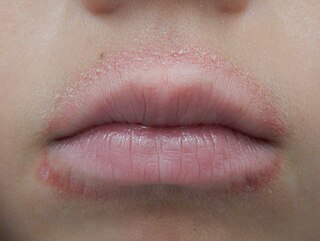
Allergies, also known as allergic diseases, refer to a number of conditions caused by the hypersensitivity of the immune system to typically harmless substances in the environment. These diseases include hay fever, food allergies, atopic dermatitis, allergic asthma, and anaphylaxis. Symptoms may include red eyes, an itchy rash, sneezing, coughing, a runny nose, shortness of breath, or swelling. Note: food intolerances and food poisoning are separate conditions.

Dermatitis is inflammation of the skin, typically characterized by itchiness, redness and a rash. In cases of short duration, there may be small blisters, while in long-term cases the skin may become thickened. The area of skin involved can vary from small to covering the entire body. Dermatitis is often called eczema, and the difference between those terms is not standardized.

Contact dermatitis is a type of acute or chronic inflammation of the skin caused by exposure to chemical or physical agents. Symptoms of contact dermatitis can include itchy or dry skin, a red rash, bumps, blisters, or swelling. These rashes are not contagious or life-threatening, but can be very uncomfortable.

Hives, also known as urticaria, is a kind of skin rash with red, raised, itchy bumps. Hives may burn or sting. The patches of rash may appear on different body parts, with variable duration from minutes to days, and does not leave any long-lasting skin change. Fewer than 5% of cases last for more than six weeks. The condition frequently recurs.
Omalizumab, sold under the brand name Xolair, is a medication used to treat asthma, nasal polyps, and urticaria (hives).

Atopy is the tendency to produce an exaggerated immunoglobulin E (IgE) immune response to otherwise harmless substances in the environment. Allergic diseases are clinical manifestations of such inappropriate, atopic responses.

Atopic dermatitis (AD), also known as atopic eczema, is a long-term type of inflammation of the skin (dermatitis). It results in itchy, red, swollen, and cracked skin. Clear fluid may come from the affected areas, which often thickens over time. While the condition may occur at any age, it typically starts in childhood, with changing severity over the years. In children under one year of age, much of the body may be affected. As children get older, the areas on the insides of the knees and elbows are most commonly affected. In adults, the hands and feet are most commonly affected. Scratching the affected areas worsens the symptoms, and those affected have an increased risk of skin infections. Many people with atopic dermatitis develop hay fever or asthma.

Ketotifen, sold under the brand name Zaditor among others, is a second-generation noncompetitive H1-antihistamine and mast cell stabilizer. It is most commonly sold as a salt with fumaric acid, ketotifen fumarate, and is available in two forms. In its ophthalmic form, it is used to treat allergic conjunctivitis. In its oral form, it is used to prevent asthma attacks or anaphylaxis, as well as various mast cell, allergic-type disorders.

Prurigo nodularis (PN), also known as nodular prurigo, is a skin disease characterised by pruritic (itchy) nodules which usually appear on the arms or legs. Patients often present with multiple excoriated lesions caused by scratching. PN is also known as Hyde prurigo nodularis, Picker's nodules, atypical nodular form of neurodermatitis circumscripta, lichen corneus obtusus.

CCL17 is a powerful chemokine produced in the thymus and by antigen-presenting cells like dendritic cells, macrophages, and monocytes. CCL17 plays a complex role in cancer. It attracts T-regulatory cells allowing for some cancers to evade an immune response. However, in other cancers, such as melanoma, an increase in CCL17 is linked to an improved outcome. CCL17 has also been linked to autoimmune and allergic diseases.
Aquagenic urticaria, also known as water allergy and water urticaria, is a rare form of physical urticaria in which hives develop on the skin after contact with water, regardless of its temperature. The condition typically results from contact with water of any type, temperature or additive.

A Dennie–Morgan fold, also known as a Dennie–Morgan line or an infraorbital fold, is a fold or line in the skin below the lower eyelid. It can simply be an ethnic/genetic trait, but was found in one study to occur in 25% of patients with atopic dermatitis. The presence of Dennie–Morgan folds can be used as a diagnostic marker for allergy, with a sensitivity of 78% and specificity of 76% for atopic dermatitis according to one study, although another study found them to be of diagnostic significance in atopic dermatitis. The condition was described by Charles Clayton Dennie and David B. Morgan in 1948.
Torsten Zuberbier is a German dermatologist and allergologist.

Alain L. de Weck,, was a Swiss immunologist and allergist. His main scientific contributions were in the area of characterization and prevention of drug allergy. He was the founding director of the Institute of Clinical Immunology at the University of Bern from 1971 to 1993 and authored or co-authored over 600 peer-reviewed publications. He is the recipient of a number of patents that led to commercial allergy products and services. He served as president of international scientific organizations such as the International Union of Immunological Societies (IUIS) and the International Association for Allergy and Clinical Immunology (IAACI) and was founder and later CEO of the Centre Médical des Grand-Places (CMG) company, acquired by Heska of Fort Collins in 1997. In later years he continued his research at the University of Navarra in Spain and wrote on a wide range of topics such as the distinction between science and pseudo-science, the emergence of genetically modified organisms (GMOs) and comparative health care policy.
A sweat allergy is the exacerbation of atopic dermatitis associated with an elevated body temperature and resulting increases in the production of sweat. It appears as small reddish welts that become visible in response to increased temperature and resulting production of sweat. It can affect all ages. Sweating can trigger intense itching or cholinergic urticaria. The protein MGL_1304 secreted by mycobiota (fungi) present on the skin such as Malassezia globosa acts as a histamine or antigen. People can be desensitized using their own samples of sweat that have been purified that contains small amounts of the allergen. The allergy is not due to the sweat itself but instead to an allergy-producing protein secreted by bacteria found on the skin.

Lip licker's dermatitis is a type of skin inflammation around the lips due to damage by saliva from repetitive lip licking and is classified as a subtype of irritant contact cheilitis. The resulting scaling, redness, chapping, and crusting makes a well-defined ring around the lips. The rash may extend as far as the tongue can reach and usually does not occur at the corners of the mouth. It commonly occurs during winter months but some people can have it year-round if lip licking is a chronic habit.
Histopathology of dermatitis can be performed in uncertain cases of inflammatory skin condition that remain uncertain after history and physical examination.

Andrii Ihorovych Kurchenko is a Ukrainian dermatologist, immunologist and allergologist, Doctor of Sciences in Medicine, Professor, head of department of Clinical Immunology and Allergology at O.Bohomolets National Medical University. He is an Expert of the Scientific and Expert Council at the State Expert Center of the Ministry of Health of Ukraine, a Fellow of the European and American Academies of Allergology and Clinical Immunology and Vice-President of the Ukrainian Society of experts in Immunology, Allergology and Immune rehabilitation (UTIAI). He is Deputy-editor of the journal "Immunology and Allergology. Science and Practice", as well as a co-author of the national textbooks "Clinical and Laboratory Immunology" (2012) and "Immunology" (2013).

Giorgio Walter Canonica is an Italian allergist, pulmonologist and professor of Respiratory Medicine at Humanitas University, Milan, Italy and Director Personalized Medicine Asthma & Allergy Center at Humanitas Research Hospital IRCCS-Milano Italy since December 2016. He is known for his research work related to innovative treatment strategies for allergic diseases which includes biological response modifier in form of targeted immunotherapy with primary emphasis on sublingual immunotherapy (SLIT). He has served as Secretary General and President elect of World Allergy Organisation for six consecutive years and has served as president of the same organization during 2007–09. He is also the vice-president of INTERASMA.
Bernadette Eberlein is a dermatologist, allergologist, academic, and researcher. She is the Senior Physician of the private outpatient clinic, the Photodermatology unit, the unit for Soft X-Ray Therapy at Technical University of Munich.














